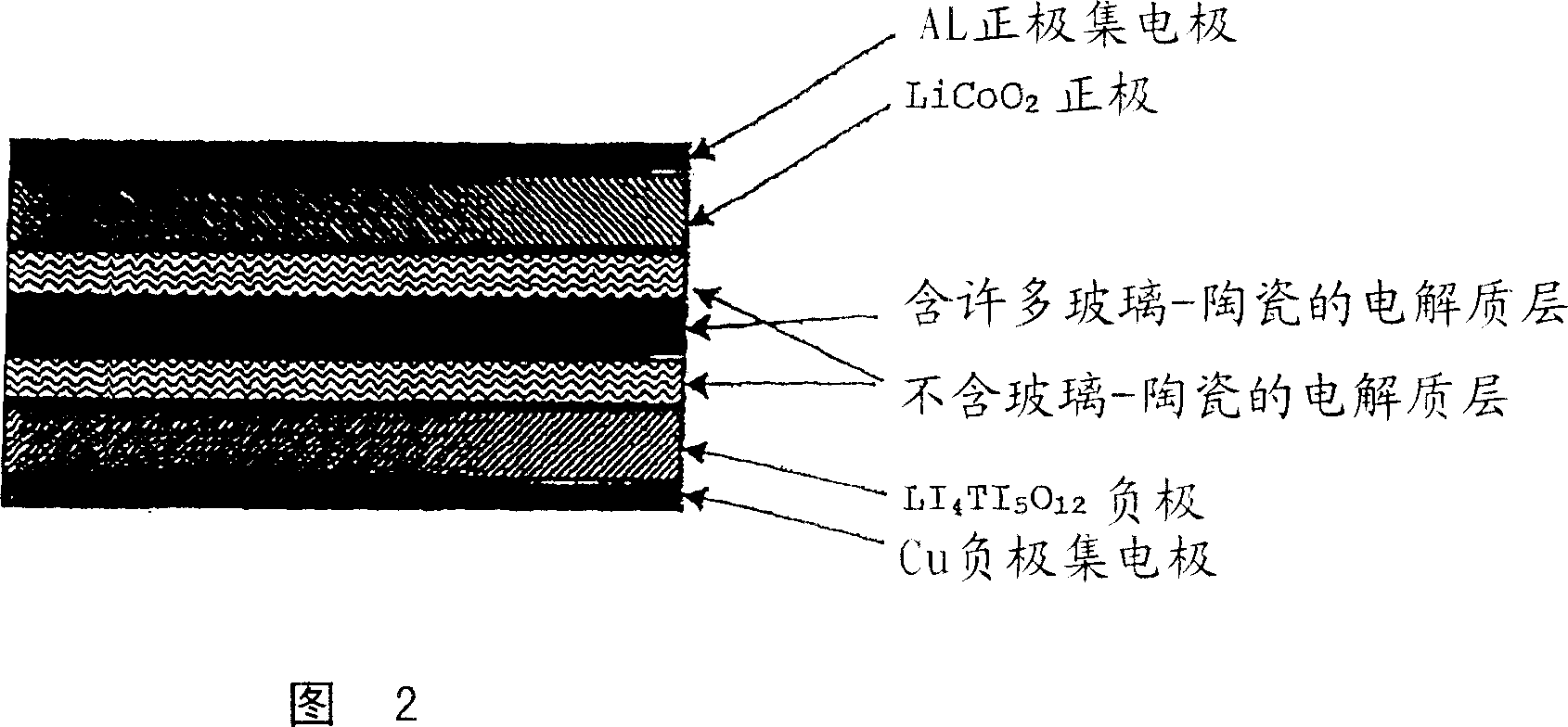Lithium ion secondary battery and solid electrolyte therefor
A solid electrolyte and secondary battery technology, which is applied in the manufacture of batteries with solid electrolytes, secondary batteries, and secondary batteries, etc., can solve the problems of difficult to achieve high output batteries, difficult to achieve close contact, and increased interface resistance. Ease of processing, reduced distance, and improved heat-resistant temperature
- Summary
- Abstract
- Description
- Claims
- Application Information
AI Technical Summary
Problems solved by technology
Method used
Image
Examples
Embodiment 1
[0088] (Preparation of lithium-ion conductive glass-ceramics)
[0089] Weigh raw material H 3 PO 4 , Al(PO 3 ) 3 , Li 2 CO 3 , SiO 2 and TiO 2 And mix well to make 35.0%P 2 o 5 , 7.5% Al 2 o 3 , 15.0% Li 2 O, 38.0%TiO 2 and 4.5% SiO 2 The composition of the oxide is expressed in mole percent on an oxide basis. The mixture was put into a platinum pot, heated and melted in an electric furnace at 1500° C. for 3 hours while stirring the molten glass. The molten glass is then poured into running water to produce glass flakes. The glass was heated at 950° C. for 12 hours to crystallize, whereby the target glass-ceramic was obtained. By powder X-ray diffraction, it was confirmed that the main crystal phase was Li 1+x+y Al x Ti 2-x Si y P 3-y o 12 (0≤x≤0.4, 0<y≤0.6). The resulting glass-ceramic flakes were pulverized by a jet mill and a glass-ceramic powder having an average particle diameter of 5 micrometers and a maximum particle diameter of 20 micrometers was...
Embodiment 2
[0105] (preparation of solid electrolytes containing many glass-ceramics)
[0106] The glass-ceramic powder obtained in Example 1 and LiBF loaded as a lithium salt 4 The copolymer of polyethylene oxide and polypropylene oxide is uniformly mixed in the ratio of 80:20 in the case of using a mixed solvent of NMP (N-methyl-2-pyrrolidone) and THF (tetrahydrofuran), and passed through a roller The coater coated the mixture on a PET film that had been subjected to mold release treatment and dried it, and then dried it at 120° C. under reduced pressure, and removed the solvent by evaporation to obtain a solid electrolyte sheet having a thickness of 30 μm. Another PET film which had been subjected to a release treatment was adhered to the solid electrolyte thus obtained. The composite electrolyte was then heated at 150 °C and squeezed through a roller press to remove the air bubbles retained in the solid electrolyte. Then, the PET film on both sides of the solid electrolyte was peele...
Embodiment 3
[0126] (preparation of solid electrolyte)
[0127]Weigh raw material H 3 PO 4 , Al(PO 3 ) 3 , Li 2 CO 3 , SiO 2 、TiO 2 and GeO 2 And mix well to make 37.0%P 2 o 5 , 8%Al 2 o 3 , 15.0% Li 2 O, 20.0%TiO 2 , 4% SiO 2 and 16% GeO 2 The composition of the oxide is expressed in mole percent on an oxide basis. The mixture was placed in a platinum pot, heated and melted in an electric furnace at 1400° C. for 3 hours while stirring the molten glass. Molten glass is poured into stainless steel molds to produce glass sheets. The glass was heated at 900° C. in an electric furnace, whereby a target glass-ceramic plate was obtained. By powder X-ray diffraction, it was confirmed that the main crystal phase was Li 1+x+y al x Ti 2-x Si y P 3-y o 12 (wherein 0≤x≤0.4, 0<y≤0.6), wherein part of Ti is replaced by Ge.
[0128] This glass-ceramic was cut into Φ20 mm, and both surfaces thereof were polished to obtain a disk-shaped glass-ceramic (solid electrolyte) having a th...
PUM
| Property | Measurement | Unit |
|---|---|---|
| thickness | aaaaa | aaaaa |
| thickness | aaaaa | aaaaa |
| thickness | aaaaa | aaaaa |
Abstract
Description
Claims
Application Information
 Login to View More
Login to View More - R&D
- Intellectual Property
- Life Sciences
- Materials
- Tech Scout
- Unparalleled Data Quality
- Higher Quality Content
- 60% Fewer Hallucinations
Browse by: Latest US Patents, China's latest patents, Technical Efficacy Thesaurus, Application Domain, Technology Topic, Popular Technical Reports.
© 2025 PatSnap. All rights reserved.Legal|Privacy policy|Modern Slavery Act Transparency Statement|Sitemap|About US| Contact US: help@patsnap.com


